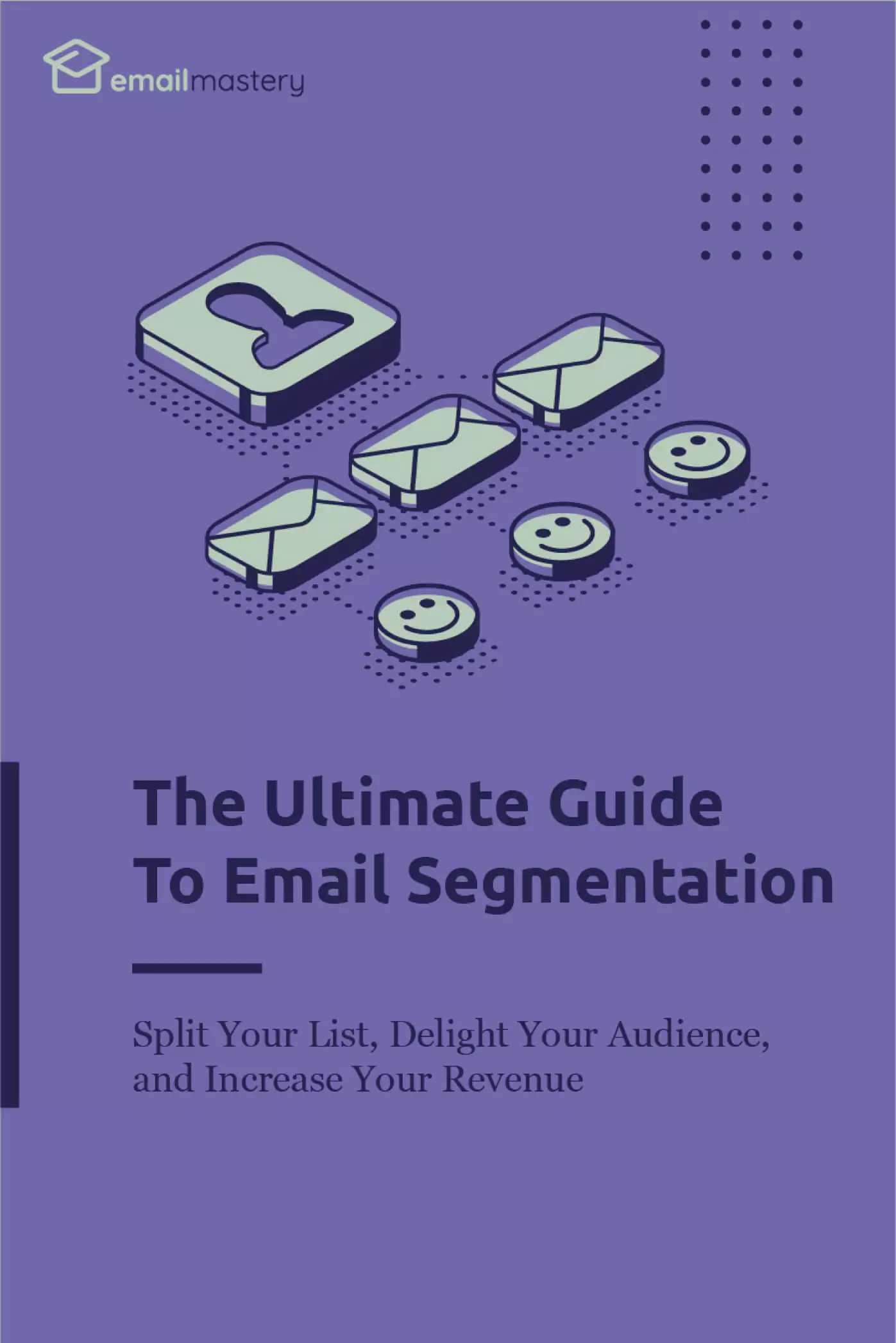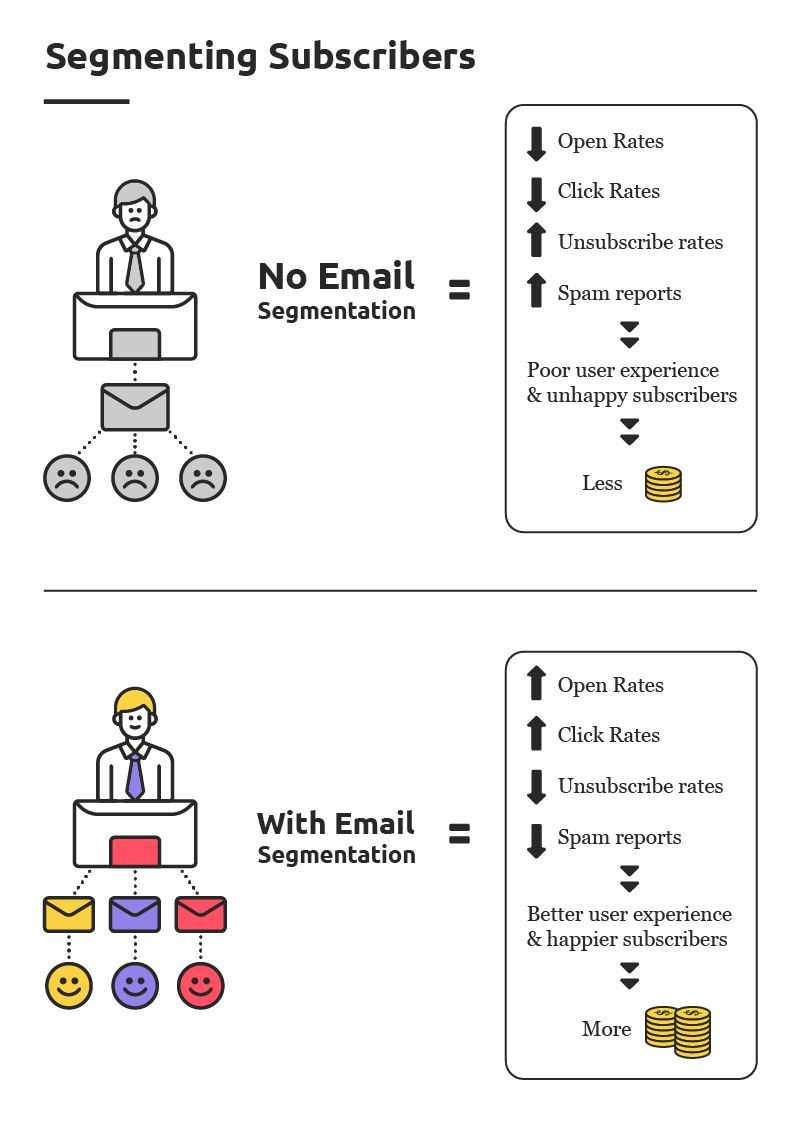
Chapter 1: What is email segmentation?
Put simply, email segmentation is splitting your list into groups for the purpose of improving engagement and conversions. Because the fact is, not all of your subscribers are the same.
Some people joined your email list, for example, because they’re interested in this product (wine) and some joined because they’re interested in that product (whiskey). Still others joined because they’re mostly interested in the free content and advice you offer (for now, at least).
Fortunately, there are commonalities between the people on your list — natural groupings of people with similar interests. And you can use email segmentation to send the right emails to the right people at the right time.

As we saw earlier, segmentation results in a higher open rate, click-through rate, and even more revenue for your business.
(Because, after all, you’re sending each of your subscribers what they want, when they want it)
But the most sophisticated email marketers don’t just put their subscribers in buckets and call it a day. They actively reassess based on how their subscriber’s interests have changed and where each subscriber now fits in their sales funnel.
Since segmentation is based on a funnel where people move from awareness to interest and from desire to conversion, a good segmentation strategy moves with the subscribers, adapting as needed.
But more on that later.
For now, let’s take a quick minute to talk about something called cohorts.
What are email cohorts?
Before you can fully understand segmentation, you also should understand what cohorts are.
For our purposes, cohorts are groups of email subscribers that share a quality, behavior, interest, or desire. You might, for example, group subscribers into a cohort of people who have only purchased once. Or you might create a cohort of subscribers that are between the ages of 20 and 25. Your imagination is the limit — you can create a cohort based on anything that you think is significant or important for marketing to your audience. You can then create a segment based on a cohort.
Here are a few qualities that you can use to create cohorts (running a survey can be a great way to collect the data for cohorts and segments)…
- Age (young vs. old)
- Amount of time on email list (new subscriber vs. old subscriber)
- Number of purchases (new buyer vs. long-term customer)
- Point in sales funnel (awareness vs. consideration)
- Source/medium of first contact (social media vs. SEO)
- Interest (wine vs. whiskey)
Even someone who’s new to email segmentation can take advantage of some of those simpler cohorts, increasing engagement and business revenue.
Remember, though, just because a subscriber is placed in a specific cohort now doesn’t mean they’re going to be in that cohort forever. People — your subscribers — change, and your segmentation strategy should reflect that.
Note: Some cohorts change over time, others don’t. An interest-based segmentation strategy will need to remain flexible to each subscriber’s changing interests. But a cohort based on, say, year of college graduation, doesn’t need to be flexible. Subscribers only graduated once from college and they’ll always be in that specific cohort (“2015 graduate”, for example).
In the next chapter, we’re going to discuss some popular email segments that email marketers use and how you can use those segments to better serve your audience.
But first, let’s take a quick look at some super compelling email segmentation stats…
- Marketers who use segmented email campaigns experience up to a 760% increase in revenue.
- Segmented campaigns have a 14% higher open rate and a 100% higher click-through rate than non-segmented campaigns.
- Segmented and targeted email campaigns generate 58% of all revenue.
- Segmented campaigns have a 4% lower bounce rate than non-segmented campaigns.
Not too shabby, eh?
Well, those stats are good news for you! Email segmentation really can help you build a better relationship with your audience, increase engagement, and even drive revenue.
But before we close out this chapter, a quick note about email personalization.
Where does personalization fit into your segmentation strategy?
Here’s how Campaign Monitor defines personalization…
“Personalization, in the context of email marketing, is the act of targeting an email campaign to a specific subscriber by leveraging the data and information you have about them. It could be information like their first name, the last product they bought, where they live, how many times they log into your app, or a number of other data points.”
And there’s quite a bit of online discussion about the difference between personalization and segmentation.
So let’s set the record straight.
On one hand, personalization works to personalize each subscriber’s experience — that is, craft it for the individual (based on name, business name, age, or past product purchases).
Segmentation, on the other hand, works to personalize each cohort’s experience — that is, craft it for a specific group of people with a common interest, quality, or desire.
There is some overlap, though. Using each subscriber’s first name is certainly a personalization tactic, just as creating interest-based cohorts is purely a segmentation strategy. But creating a “Recommended Products For You!” column or sending different emails to different genders? Those things enter the realm of both personalization and segmentation.
That’s not a bad thing.
So long as you’re careful about how the two strategies interact, using personalization and segmentation can be insanely powerful. But a few quick words of caution.
- Make sure your tactics play well together — Since there is some common overlap between personalization and segmentation, it’s important to make sure that subscribers getting served one thing from your personalization strategy and another thing from your segmentation strategy end up with a consistent experience. It would be weird, for example, if a man who purchased women’s clothing was then segmented as a woman in your email list (maybe he was just buying a gift for his wife) and even weirder if you’re still using his correct name.
- Personalization can backfire — While the stats on personalization promise to increase engagement and conversion rates, keep in mind that it can also backfire. If you’ve only collected first name information for some of your subscribers, for instance, and then you include the “first name” tag within an email, some of your subscribers are going to get a weird space in between “Hey” and the comma (“Hey ,”), or worse, they’ll see the actual tag (“Hey <first_name>,”). Nothing ruins a personalization strategy quite as fast as those silly little mistakes.
Now let’s discuss what kinds of segments and cohorts you should consider creating. The ones you choose largely depends on your business goals and on who your audience is.
